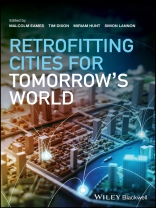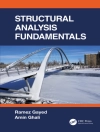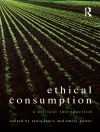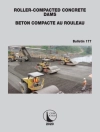A groundbreaking exploration of the most promising new ideas for creating the sustainable cities of tomorrow
The culmination of a four-year collaborative research project undertaken by leading UK universities, in partnership with city authorities, prominent architecture firms, and major international consultants, Retrofitting Cities for Tomorrow’s World explores the theoretical and practical aspects of the transition towards sustainability in the built environment that will occur in the years ahead. The emphasis throughout is on emerging systems innovations and bold new ways of imagining and re-imagining urban retrofitting, set within the context of ‘futures-based’ thinking.
The concept of urban retrofitting has gained prominence within both the research and policy arenas in recent years. While cities are often viewed as a source of environmental stress and resource depletion they are also hubs of learning and innovation offering enormous potential for scaling up technological responses. But city-level action will require a major shift in thinking and a scaling up of positive responses to climate change and the associated threats of environmental and social degradation. Clearly the time has come for a more coordinated, planned, and strategic approach that will allow cities to transition to a sustainable future. This book summarizes many of the best new ideas currently in play on how to achieve those goals.
- Reviews the most promising ideas for how to approach planning and coordinating a more sustainable urban future by 2050 through retrofitting existing structures
- Explores how cities need to govern for urban retrofit and how future urban transitions and pathways can be managed, modeled and navigated
- Offers inter-disciplinary insights from international contributors from both the academic and professional spheres
- Develops a rigorous conceptual framework for analyzing existing challenges and fostering innovative ways of addressing those challenges
Retrofitting Cities for Tomorrow’s World is must-reading for academic researchers, including postgraduates insustainability, urban planning, environmental studies, economics, among other fields. It is also an important source of fresh ideas and inspiration for town planners, developers, policy advisors, and consultants working within the field of sustainability, energy, and the urban environment.
Inhaltsverzeichnis
List of Contributors xi
Biographies xv
Foreword xxi
Preface xxiii
Reviews xxv
1 Introduction 1
Tim Dixon, Malcolm Eames, Miriam Hunt and Simon Lannon
1.1 The Future (or ‘Tomorrow’s World’) of Cities 4
1.2 The Structure of the Book 7
1.2.1 Part One: Governance and Dynamics of Urban Retrofit 7
1.2.2 Part Two: Modelling Urban Transitions and Pathways 10
1.2.3 Part Three: Steering and Navigating Sustainable Urban Transitions 11
1.2.4 Part Four: Overview of Key Themes from the Book 14
References 14
Part I Governance and Dynamics of Urban Retrofit 17
2 Community Housing Retrofit in the UK and the Civics of Energy Consumption 19
Andrew Karvonen
2.1 Challenges to Systemic Housing Retrofit 20
2.2 Community and Low?]Carbon Futures 21
2.3 Community Housing Retrofit 22
2.3.1 Community as Local Governance Strategy 23
2.3.2 Community as Identity 23
2.3.3 Community as Learning Network 24
2.3.4 Community as Ethical Commitment 25
2.4 Community Housing Retrofit and the Civics of Low?]carbon Transitions 26
2.5 Conclusions 27
References 28
3 ‘City?]wide or City?]blind’? An Analysis of Retrofit Practices in the UK Commercial Property Sector 33
Tim Dixon
3.1 Introduction 34
3.2 UK Commercial Property: Nature and Characteristics of Commercial Property 36
3.3 What Conceptual Frameworks Can We Use to Understand Commercial Property Retrofitting? 37
3.4 Research Findings 40
3.4.1 ‘Who’? – The Main Stakeholders in the Commercial Property Retrofit Regime and the Nature of the Regime 40
3.4.2 ‘What’? – Retrofit Defined and the Key Technologies Being Used 41
3.4.3 ‘Why’? – The Key Drivers and Barriers 42
3.4.4 ‘How’? – Institutional Frameworks, Legislation and Monitoring/Standards 45
3.5 Conclusions and Discussion 46
Acknowledgements 48
References 48
4 Performance Gap in ‘Deep’ Retrofit of Housing: Issues at the Design and Construction Interface 53
Will Swan, Niloufar Bayat and Graeme Sheriff
4.1 Introduction 53
4.2 Defining the Performance Gap 55
4.3 Methodology – Expert Interviews 56
4.4 Findings 58
4.4.1 Theme 1 – Understanding and Skills 58
4.4.2 Theme 2 – Working Practices 60
4.4.3 Theme 3 – Hard to Treat 62
4.5 Conclusions 63
References 64
5 Transforming the Commercial Property Market in Australians Cities: Contemporary Practices and the Future Potential in Green Roof Retrofit 69
Sara J. Wilkinson, Paul van der Kallen, Allan Teale and Hera Antoniades
5.1 Introduction 69
5.2 Green Roofs Defined 70
5.3 Retrofit Issues in Commercial Stock in Australian Cities 72
5.4 Drivers for Green Roofs 73
5.5 Transformation of the Commercial Property Stock 75
5.6 Valuation Issues 76
5.7 Retrofitting Investment to Date 78
5.8 Taxation Considerations 79
5.9 Contemporary Practices 80
5.9.1 Green Roof Retrofit in Commercial Stock – Case Studies from Melbourne and Sydney 80
5.10 Future Potential in Green Roof Retrofit 85
5.11 Conclusions 86
Acknowledgements 87
References 87
Part II Modelling Urban Transitions and Pathways 91
6 Modelling Residential Retrofit: Insights on the Effect of Regional Characteristics for the Cardiff City Region 93
Malcolm Eames, Simon Lannon, Miriam Hunt and Aliki Georgakaki
6.1 Introduction 93
6.2 Context 94
6.2.1 Role of Local Government 94
6.2.2 Cardiff Domestic Stock: History and Legacy 95
6.3 Methodology 96
6.4 Results 101
6.4.1 Wall Insulation 104
6.4.2 Loft Insulation 104
6.4.3 Glazing 105
6.5 Conclusions 106
Acknowledgements 106
References 106
7 Weatherproofing Urban Social Housing for a Changing Climate Through Retrofitting: A Holistic Approach 109
Anna Mavrogianni, Jonathon Taylor, Michael Davies and John Kolm?]Murray
7.1 Scope 109
7.2 The UK Housing Retrofit Challenge and Potential Unintended Consequences 110
7.3 Challenges and Opportunities for Social Housing Retrofit 110
7.4 The Building Envelope as a Climate Modifier 111
7.5 The Role of Seasonal Health Policy 112
7.6 South Islington: A Case Study 113
7.6.1 Climate Risk Awareness and Behaviour 113
7.6.2 Indoor Summer Thermal Comfort and Environmental Quality 114
7.7 Conclusions 120
Acknowledgements 120
References 121
8 What is Hindering Adaptation to Climate Change in English Suburbs, and What Would Help Facilitate Action? 125
Ian Smith, Katie Williams and Rajat Gupta
8.1 Introduction 125
8.2 What is the Suburban Retrofitting Problem? 126
8.3 Hot in the Suburbs? 127
8.4 How Does the Current Literature Explain Why Retrofitting Might Happen? 130
8.5 Conclusions 136
References 137
9 The Value of Foresight and Scenarios in Engineering Liveable Future Cities 139
Chris Rogers
9.1 Introduction 139
9.2 Retrofitting the Underworld 141
9.3 The Foresight Future of Cities Project 142
9.4 Scenarios 146
9.5 Conclusions 149
Acknowledgements 149
References 150
Part III Steering and Navigating Sustainable Urban Transitions 153
10 Urban Sustainability Transition: Retrofitting the City 155
Derk Loorbach
10.1 Introduction 156
10.2 Transitions as the Analytical Starting Point for Addressing Urban Transitions 157
10.3 Sustainability Transitions in Urban Areas 159
10.4 A Transition in the Urban Built Environment? 162
10.5 Transition Project ‘Energiesprong’ 163
10.6 Transition Management and the Built Environment 165
10.7 Outlook: Transitioning the City? 168
References 169
11 Presenting Futures: London 2062 171
Sarah Bell
11.1 Introduction 171
11.2 UCL’s Grand Challenges 173
11.3 London 2062 173
11.3.1 Connections 175
11.3.2 Things 175
11.3.3 Power 176
11.3.4 Dreams 177
11.3.5 Imagining the Future City 177
11.4 Conclusions
178
References 179
12 Framing New Retrofit Models for Regenerating Australia’s Fast Growing Cities 183
Peter W. Newton
12.1 Introduction 183
12.2 Current State, Future Trajectories and Retrofitting Challenges for Australia’s Largest Cities 184
12.3 The Challenge of Regenerative Urban Transition 186
12.3.1 Scale of Built Environment Innovation 187
12.3.2 Urban Form and Fabric 187
12.3.3 Urban Development Arenas 187
12.4 Greyfield Infill Redevelopment 194
12.5 Towards a New Model for Residential Precinct Regeneration 196
12.5.1 Public Housing as a Catalyst for Neighbourhood Regeneration 197
12.5.2 Precinct Regeneration in Greyfields Private Property Market: Municipal Housing Strategies as a Catalyst for Neighbourhood Regeneration 198
12.6 Conclusion 201
Acknowledgements 202
References 203
13 City?]regional Futures in Context: Insights from the Retrofit 2050 Project 207
Carla De Laurentis, Malcolm Eames, Miriam Hunt and Tim Dixon
13.1 Introduction 207
13.2 City Futures as Guiding Visions 210
13.3 How Can We Use City Visions to Understand City Futures of Tomorrow? 212
13.4 Exploring Visions of Cities in Context: Cardiff 2050 217
13.5 Concluding
Remarks 222
References 223
14 National Policies for Local Urban Sustainability: A New Governance Approach? 227
Simon Joss and Robert Cowley
14.1 Introduction 227
14.2 Four National Sustainable City Programmes in Profile 229
14.2.1 Eco Cities (India) 229
14.2.2 Eco Quartier (France) 231
14.2.3 Eco?]Model City (Japan) 234
14.2.4 Future Cities (UK) 237
14.3 Comparative Observations 238
14.3.1 Shaping the Content of Local Agendas 239
14.3.2 Governance Innovation 240
14.3.3 Factors Co?]determining Policy Implementation Success/Failure 241
14.4 Conclusions 242
References 243
Part IV Overview of Key Themes from the Book 247
15 Conclusions and Reflections: Retrofitting Cities for Tomorrow’s World 249
Malcolm Eames, Tim Dixon, Miriam Hunt and Simon Lannon
15.1 Introduction 249
15.2 Critical Factors for Successful Urban Retrofit Transition 250
15.2.1 Emerging Themes from the Book 250
15.2.2 EPSRC Retrofit 2050: Main Findings 252
15.3 Summary: Foresight for a Tomorrow’s World of Cities 260
References 262
Index 267
Über den Autor
Malcolm Eames, Ph D until recently held a professorial chair in Low Carbon Research with the Low Carbon Research Institute at the Welsh School of Architecture, Cardiff University, UK, and was the Principal Investigator for the EPSRC Retrofit 2050 project. Tim Dixon, Ph D holds a professorial chair in Sustainable Futures in the Built Environment in the School of the Built Environment at the University of Reading and leads the Sustainability in the Built Environment (Sust BE) network. Miriam Hunt is a Ph D student at School of Social Sciences, Cardiff University, UK. Simon Lannon, Ph D is a research fellow at the Welsh School of Architecture, Cardiff University, UK.












